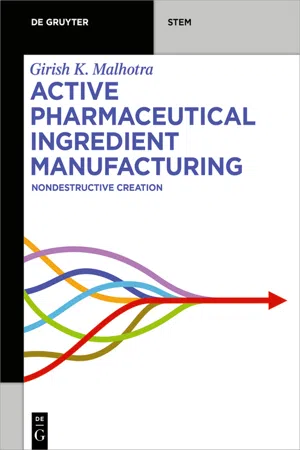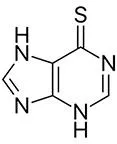
eBook - ePub
Active Pharmaceutical Ingredient Manufacturing
Nondestructive Creation
- 310 pages
- English
- ePUB (mobile friendly)
- Available on iOS & Android
eBook - ePub
About this book
The book reviews the history of current brand and generic business in pharmaceuticals manufacturing practices. Based on examples, the reader can interpolate, extrapolate and exploit mutual behavior (physical and chemical properties) of chemicals to design and commercialize processes that fulfi ll the demands, also manipulate chemical unit processes and unit operations to reduce/minimize effl uents and lower environmental impact i.e. reduce global warming. Readers will be able to simplify process development, design and commercialize economic manufacturing processes.
Frequently asked questions
Yes, you can cancel anytime from the Subscription tab in your account settings on the Perlego website. Your subscription will stay active until the end of your current billing period. Learn how to cancel your subscription.
At the moment all of our mobile-responsive ePub books are available to download via the app. Most of our PDFs are also available to download and we're working on making the final remaining ones downloadable now. Learn more here.
Perlego offers two plans: Essential and Complete
- Essential is ideal for learners and professionals who enjoy exploring a wide range of subjects. Access the Essential Library with 800,000+ trusted titles and best-sellers across business, personal growth, and the humanities. Includes unlimited reading time and Standard Read Aloud voice.
- Complete: Perfect for advanced learners and researchers needing full, unrestricted access. Unlock 1.4M+ books across hundreds of subjects, including academic and specialized titles. The Complete Plan also includes advanced features like Premium Read Aloud and Research Assistant.
We are an online textbook subscription service, where you can get access to an entire online library for less than the price of a single book per month. With over 1 million books across 1000+ topics, we’ve got you covered! Learn more here.
Look out for the read-aloud symbol on your next book to see if you can listen to it. The read-aloud tool reads text aloud for you, highlighting the text as it is being read. You can pause it, speed it up and slow it down. Learn more here.
Yes! You can use the Perlego app on both iOS or Android devices to read anytime, anywhere — even offline. Perfect for commutes or when you’re on the go.
Please note we cannot support devices running on iOS 13 and Android 7 or earlier. Learn more about using the app.
Please note we cannot support devices running on iOS 13 and Android 7 or earlier. Learn more about using the app.
Yes, you can access Active Pharmaceutical Ingredient Manufacturing by Girish K. Malhotra in PDF and/or ePUB format, as well as other popular books in Technology & Engineering & Clinical Chemistry. We have over one million books available in our catalogue for you to explore.
Information
Chapter 1 History of pharmaceuticals
We try to remember that medicine is for the patient. We try never to forget that medicine is for the people. It is not for the profits. The profits follow, and if we have remembered that, they have never failed to appear. The better we have remembered it, the larger they have been.– George W. Merck Time Magazine August 19, 1952 [1]
1.1 History of pharmaceuticals: their evolution
Going through history, growth and development of the pharmaceutical industry is fascinating from seventeenth century onward. We get to see how various companies will have meaning to history buffs. However, to the current generation, it would be how some companies have appeared and how their names got changed through mergers, demergers, truncations, and change of vision. A short history of some of the companies is presented. Some of the recent mergers (last 5 years) are not included.
1.1.1 Beginning
Different botanical plants were used for remedies of various ailments. Companies started offering soaps, skin care, and distinctive medications for different common diseases. A close look at the companies involved presents an interesting journey. Pharmaceutical industry’s current form really started to take place around late sixteenth and early seventeenth centuries [2, 3, 4]. Wikipedia has been an excellent source of most of the citations. Table 1.1 is a brief compilation of evolution of the pharmaceutical companies. It is difficult to go into the detailed history of each company. The following narrative is an extremely brief summary. Included references are just “tip of the iceberg.” Books can be written about each company’s history.
Tab. 1.1:Pharmaceutical companies from sixteenth century to present.
| Company | Current name |
|---|---|
| Glaxo Smith Kline Beecham Wellcome Research Labs | GlaxoSmithKline |
| Merck Schering Plough | Merck |
| Pfizer American Cyanamid (Lederle Labs) Warner Lambert Parke Davis Upjohn Wyeth Pharmacia King Pharmaceuticals Hospira G. D. Searle | Pfizer |
| Bayer AG | Bayer |
| Merck KGaA Schering | Merck KGaA |
| Eli Lilly | Eli Lilly |
| Abbott Labs | Abbott |
| AbbVie | |
| Imperial Chemical Industries (Zeneca) Astra | Astra-Zeneca |
| Bristol Myers Squibb | Bristol Myers Squibb |
| Ciba Geigy Sandoz | Novartis |
| Hoffmann-La Roche | Roche |
| Johnson & Johnson | Johnson & Johnson |
| Boots | Walgreens |
| Boehringer Ingelheim | Boehringer Ingelheim |
| Sanofi | Sanofi |
| Aventis | |
| Novo-Nordisk |
It is interesting to note that some of these companies got their start as a dye and fine chemical business in the seventeenth century. Researchers found that many of the chemicals could selectively kill bacteria, parasites, and disease-causing microorganisms. With evolution of synthetic organic chemistry, chemists were able to convert many of the coal tar based raw materials to disease curing medicines. Their businesses grew to serve the ever-growing needs of the global population. Development of petroleum-based chemicals, continuous learning, and advances of organic chemistry synthesis facilitated the growth of the pharmaceutical industry. A walk through the major company’s evolution is a fascinating journey and worth a review as it tells us about their roots. One fact that dominates and it is not widely recognized is that a majority of the small-molecule disease-curing compounds (active pharmaceutical ingredients, API) are organic fine and specialty chemicals and their salts that kill disease-causing bacteria. If they did not have a disease-curing value, they could be an additive of some other values.
An important aspect that cannot be forgotten is that the manufacturing practices used in fine/specialty chemicals found use and value for the manufacture of disease-curing molecules. A need to to develop specific manufacturing practices for API was never an issue as these molecules could be easily synthesized in the equipment that was available and used to manufacture other similar organic molecules.
1.1.2 GlaxoSmithKline
Roots of GlaxoSmithKline (GSK) [5] go back to 1873. Joseph Nathan founded a trading company, Joseph Nathan and Co., in New Zealand. Due to excess milk being produced on the dairy farms, it started producing dried milk in 1904 and sold it under the name “Defiance.” They tried to name the product “Lacto” but their trademark was denied. They changed Lacto to Glaxo. It was sold under the slogan “Glaxo builds bonny babies.” Due to vitamin A deficiency, they sold cod liver oil as a supplement. Its first pharmaceutical product was vitamin D. It was extracted from cod liver oil and sold.
Glaxo Laboratories was incorporated as a subsidiary of Joseph Nathan and Co. in the United Kingdom in 1935. However, in 1947 shareholders bought out Joseph Nathan and Co. and reorganized the trading company to make Glaxo, the parent company.
Glaxo acquired Allen & Hanburys [6] in 1958. Glaxo bought Meyer Laboratories in 1978. It expanded its activities in the US market. In 1983, the American arm, Glaxo Inc., moved to Research Triangle Park and Zebulon (US manufacturing) in North Carolina.
Burroughs Wellcome & Company [7] was founded in 1880 in London by the American pharmacists Henry Wellcome and Silas Burroughs. In 1902, the Wellcome Tropical Research Laboratories was established. In the 1920s, Burroughs Wellcome established research and manufacturing facilities in Tuckahoe, New York. It served as the US headquarters until the company moved to Research Triangle Park in North Carolina in 1971. The Nobel Prize-winning scientists Gertrude B. Elion and George H. Hitchings invented drugs such as mercaptopurine [Figure 1.1], which is used for cancer and autoimmune diseases, and are still used many years later.

Fig. 1.1: Mercaptopurine (3,7-dihydropurine-6-...
Table of contents
- Title Page
- Copyright
- Contents
- Preface
- Chapter 1 History of pharmaceuticals
- Chapter 2 Business model: brand versus generics, product demand, process selection, and economics
- Chapter 3 Physical and chemical properties
- Chapter 4 Pharma chemistry/chemical development
- Chapter 5 Manufacturing process development and case studies
- Chapter 6 Active pharmaceutical ingredients (API): innovation, design considerations, and waste reduction
- Chapter 7 Process documentation and operating strategies
- Chapter 8 Road Map
- Index